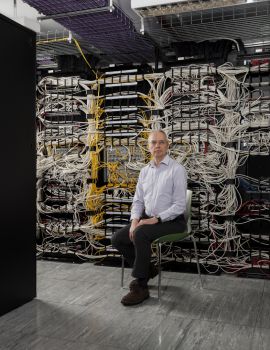Why I care about gravitational waves
By: Jacqui Bealing
Last updated: Thursday, 31 March 2016

Professor Mark Hindmarsh.. Credit: Travis Hodges
To coincide with Sussex hosting the Institute of Physics' Joint HEPP and APP conference, 21-23 March 2016, Professor Mark Hindmarsh head of the Theoretical Particle Physics group at Sussex,looks ahead to looking back in time.
The excitement of the detection of gravitational waves last month by the LIGO team still hasn’t worn off for me. It’s one thing to be convinced of their existence by a working theory - in this case Einstein’s 100-year-old general theory of relativity - it’s another to see its predictions borne out with such spectacular clarity. It’s the most exciting thing since the Higgs discovery.
The real significance is not that Einstein was right (again) but that we now have a completely new way to explore the universe, using radiation which - unlike light - is not obscured by intervening material. Gravitational waves are ripples in space itself, and go right through everything.
We now know for sure that black holes exist, that they can come in pairs with masses many times that of the Sun, and that a billion years ago two of them smashed together, making gravitational waves with enough energy to shake the whole Universe.
I want to use gravitational waves to find out what happened in the first few instants of the Big Bang. For example, the Higgs field (which gives elementary particles their masses) turned on at around 10 trillionths of a second after 'the beginning', when the Universe was so hot that every particle had roughly the energy of the colliding protons in the Large Hadron Collider,
The turning-on process might have made the whole universe behave like boiling water, and we have discovered that gravitational waves would have been generated everywhere just by the sound of the boiling. The waves would still be around today and detectable by a space-based gravitational wave detector called eLISA, being developed by the European Space Agency for launch in 2034.
The prospect of seeing right back almost to the beginning will inspire and excite physicists and the public alike in the future. The technology is amazing too - in order to detect gravitational waves, the LIGO team had to measure movements of about a millionth the size of an atom.
There are sure to be practical benefits not only from LIGO and its European counterpart VIRGO, but also from the challenge of translating the technology into space. Work has already started with the launch of LISA Pathfinder last December - I’m eagerly awaiting its results later this year.
